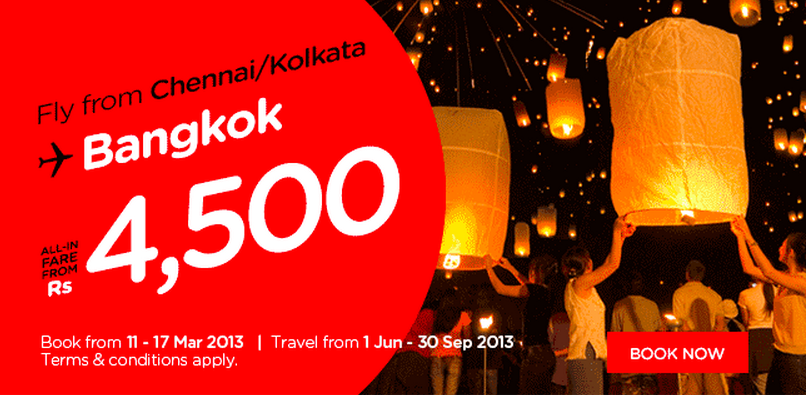AirAsia's India launch may come with free seats to grab marketshare

Skift Take
AirAsia Bhd., the region’s biggest budget carrier, is considering offering some seats for free when it starts flying in India, a move that may frustrate rivals seeking to recoup $6.6 billion of losses.
The operator plans to give away vacant seats for nothing at airports, expanding similar promotional offers at home in Malaysia, a company official with direct knowledge of the matter said, asking not to be named citing rules. Passengers will have to pay taxes and other fees, the person said. AirAsia, which is awaiting a license after winning the Indian government’s approval this month to form a joint venture, is targeting to start operations by end-2013.
Chief Executive Officer Tony Fernandes, who has said ticket prices will be the “No. 1 differentiator” in India where 60 percent of the market is controlled by discount airlines, is counting on the South Asian country for growth. His strategy may threaten a recovery at Jet Airways (India) Ltd. and SpiceJet Ltd., which are raising fares to cover costs after cash-strapped Kingfisher Airlines Ltd. ended operations in October.
“It will excite the market, but will hurt the airlines,” said Harsh Vardhan, chairman of New Delhi-based Starair Consulting that advises carriers. “AirAsia is entering a market where competition has matured. All of them have burnt their fingers, learnt their lessons and now they’ve stabilized themselves.”
Checking Costs
The company’s India venture will fly planes already ordered by its Malaysian parent and may also replicate its home model of charging a fee for services including baggage check-in, preferred seats and hot meals to boost revenue in India, the executive said. It will keep costs under check by selling tickets on-line and saving on payments to sales agents, the executive said.
“How can you reduce costs beyond a point?” Starair’s Vardhan said. “Can you reduce the salaries, can you reduce the fuel cost, taxes or airport charges? Everybody is paying the same.”
Jet fuel accounts for about half of a carrier’s expenses. India’s airports regulator last year approved to raise charges more than fourfold at the New Delhi facility, increasing costs.
“We are not commenting on the subject at all,” Aziz Laikar, spokesman of the Sepang Selangor, Malaysia-based company, said in an e-mailed response.
Depressed Earnings
AirAsia, whose profit more than tripled in 2012 to 1.9 billion ringgit ($610 million), is coming to India when the local industry is saddled with a combined $20 billion of debt. Fuel prices that cost 60 percent more than in Singapore, surging airport costs and other fees have depressed earnings even as passenger traffic doubled in the past seven years.
While about half-a-dozen operators took off in the past eight years as rising disposable incomes made air travel affordable to Indians, only IndiGo, a discount carrier, made a profit in the year ended March 31, according to government data. High taxes, inadequate infrastructure and a weaker rupee are some of the challenges airlines in India face, according to Aditya Ghosh, president of IndiGo.
As much as 70 percent of airline costs, including jet fuel and aircraft prices, are denominated in dollars, he said in Mumbai on March 17. The Indian rupee has depreciated about 17 percent against the greenback in the past two years, versus 2.5 percent for the Malaysian ringgit, according to data compiled by Bloomberg.
Enough Experience
“Forex volatility does play a crucial role in determining profit or loss,” Shukor Yusof, a Singapore-based aviation analyst at Standard & Poor’s, said in an e-mail on March 22. “However, AirAsia is operating in many different jurisdictions, including Japan, Thailand and Indonesia where forex volatility is often present and we believe it has sufficient experience to manage this.”
Boeing Co. estimates Indian airlines priced tickets as much as $11 below cost as of December 2011 as they competed to lure fliers amid high fuel costs. Jet Airways, the nation’s biggest listed carrier, hasn’t made an annual group profit in five years, while losses at state-owned Air India have mounted since the government combined Indian Airlines with the flag carrier in 2007.
SpiceJet, the nation’s only publicly traded budget airline, is headed for its second straight annual loss, according to 10 analysts’ estimates compiled by Bloomberg. Kingfisher was saddled with 85 billion rupees of debt before Chairman Vijay Mallya decided to shut down operations last year.
State Bailout
The industry in India has lost more than 360 billion rupees ($6.6 billion) since the year ended March 31, 2007, data provided by the government show. Air India last year won a 300 billion-rupee state bailout through 2020, adding to the competition.
Jet Airways shares have declined 3 percent this year, while SpiceJet has dropped 35 percent.
With one carrier less after the departure of Kingfisher, the airlines may be turning around their performance for the better, data from Boeing show. Tickets for a flight between Mumbai and Delhi may have sold for a $5 profit starting October, according to the Chicago-based aircraft maker.
Decent Profit
AirAsia aims to start Indian operations in the fourth quarter after winning approval March 6 for the nation’s first foreign aviation investment since rules were eased in September. AirAsia will own 49 percent of the Indian venture, while Tata Sons Ltd. will hold 30 percent and Arun Bhatia of Telestra Tradeplace Pvt., whose son is married to the daughter of billionaire Lakshmi Mittal, will own 21 percent.
“AirAsia is adept at offering fares that will be very competitive compared to its rivals,” S&P’s Yusof said. There are “key challenges in terms of managing India’s higher-than- average airport, fuel costs etc. But with a large pool of middle-income earners, it is within the realm of possibility for AirAsia and partners to make a decent profit.”
CEO Fernandes has expanded the carrier into the region’s biggest discount carrier by setting up ventures in the Philippines, Japan, Thailand and Indonesia. In December, the airline ordered 100 Airbus SAS A320s valued at $9.4 billion, in addition to the 200 it had agreed in 2011 to purchase.
“I won’t tell you my strategy now,” Fernandes said in an interview to Bloomberg TV on March 20. “India is a 1 billion population country, there’s plenty of places we can go. I think if we get it right, it’s massive. That’s the big question whether we can get it right.”
--Editors: Sam Nagarajan, Arijit Ghosh
To contact the reporter on this story: Karthikeyan Sundaram in New Delhi at kmeenakshisu@bloomberg.net
To contact the editor responsible for this story: Anand Krishnamoorthy at anandk@bloomberg.net
![]()




